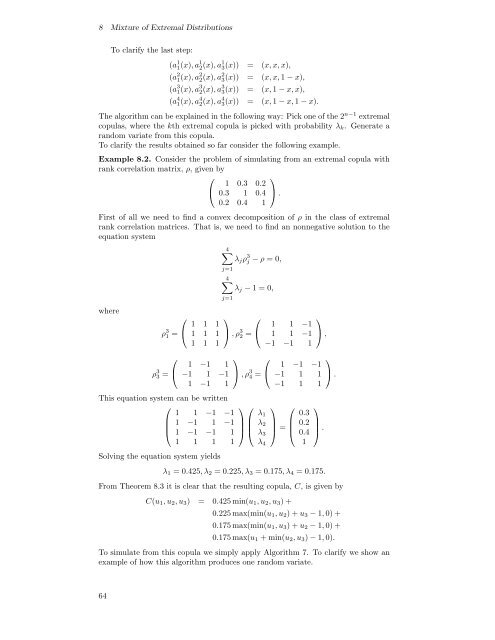Modelling Dependence with Copulas - IFOR
Modelling Dependence with Copulas - IFOR
Modelling Dependence with Copulas - IFOR
You also want an ePaper? Increase the reach of your titles
YUMPU automatically turns print PDFs into web optimized ePapers that Google loves.
8 Mixture of Extremal Distributions<br />
To clarify the last step:<br />
(a 1 1 (x),a1 2 (x),a1 3 (x)) = (x, x, x),<br />
(a 2 1 (x),a2 2 (x),a2 3 (x)) = (x, x, 1 − x),<br />
(a 3 1(x),a 3 2(x),a 3 3(x)) = (x, 1 − x, x),<br />
(a 4 1 (x),a4 2 (x),a4 3 (x)) = (x, 1 − x, 1 − x).<br />
The algorithm can be explained in the following way: Pick one of the 2 n−1 extremal<br />
copulas, where the kth extremal copula is picked <strong>with</strong> probability λ k . Generate a<br />
random variate from this copula.<br />
To clarify the results obtained so far consider the following example.<br />
Example 8.2. Consider the problem of simulating from an extremal copula <strong>with</strong><br />
rank correlation matrix, ρ, givenby<br />
⎛<br />
⎞<br />
1 0.3 0.2<br />
⎝ 0.3 1 0.4 ⎠ .<br />
0.2 0.4 1<br />
First of all we need to find a convex decomposition of ρ in the class of extremal<br />
rank correlation matrices. That is, we need to find an nonnegative solution to the<br />
equation system<br />
4∑<br />
λ j ρ 3 j − ρ =0,<br />
where<br />
j=1<br />
4∑<br />
λ j − 1=0,<br />
j=1<br />
⎛<br />
ρ 3 1 = ⎝ 1 1 1 ⎞ ⎛<br />
1 1 1 ⎠ ,ρ 3 2 = ⎝ 1 1 −1 ⎞<br />
1 1 −1 ⎠ ,<br />
1 1 1<br />
−1 −1 1<br />
⎛<br />
ρ 3 3 = ⎝ 1 −1 1 ⎞ ⎛<br />
−1 1 −1 ⎠ ,ρ 3 4 = ⎝<br />
1 −1 1<br />
This equation system can be written<br />
⎛<br />
⎞ ⎛ ⎞ ⎛<br />
1 1 −1 −1 λ 1<br />
⎜ 1 −1 1 −1<br />
⎟ ⎜ λ 2<br />
⎟<br />
⎝ 1 −1 −1 1 ⎠ ⎝ λ 3<br />
⎠ = ⎜<br />
⎝<br />
1 1 1 1 λ 4<br />
Solving the equation system yields<br />
1 −1 −1<br />
−1 1 1<br />
−1 1 1<br />
0.3<br />
0.2<br />
0.4<br />
1<br />
⎞<br />
⎟<br />
⎠ .<br />
λ 1 =0.425,λ 2 =0.225,λ 3 =0.175,λ 4 =0.175.<br />
⎞<br />
⎠ .<br />
From Theorem 8.3 it is clear that the resulting copula, C, isgivenby<br />
C(u 1 ,u 2 ,u 3 ) = 0.425 min(u 1 ,u 2 ,u 3 )+<br />
0.225 max(min(u 1 ,u 2 )+u 3 − 1, 0) +<br />
0.175 max(min(u 1 ,u 3 )+u 2 − 1, 0) +<br />
0.175 max(u 1 + min(u 2 ,u 3 ) − 1, 0).<br />
To simulate from this copula we simply apply Algorithm 7. To clarify we show an<br />
example of how this algorithm produces one random variate.<br />
64
















